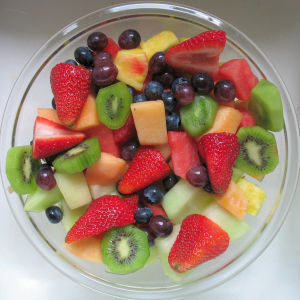More Veggies and Fruit, Please!
 Obesity has been a large problem in our country for several years now, and affects both people with and without intellectual disabilities (ID). Through The Arc’s HealthMeet project, which has conducted health assessments on over 1,000 individuals with ID in its first two years, 35% were in the obese category and 11% were in the extremely obese category.
Obesity has been a large problem in our country for several years now, and affects both people with and without intellectual disabilities (ID). Through The Arc’s HealthMeet project, which has conducted health assessments on over 1,000 individuals with ID in its first two years, 35% were in the obese category and 11% were in the extremely obese category.
According to ChooseMyPlate.Gov, half of your meals should be fruits and vegetables. While this sounds easy, many people do not meet these goals in their daily eating habits. Fruits and vegetables provide a lot of vitamins and nutrients—vitamin A, C, potassium, and iron to name a few—that our bodies need daily. They are also naturally low in fat and will help to fill you up without all the additional calories, so feel free to eat as much of them as you’d like! Just be careful about extra toppings that you may add on. For example, make sure not to add an excessive amount of butter or cheese to things like broccoli or brussels sprouts, and use salt sparingly.
Below are a few easy ways to help increase your fruit and vegetable consumption throughout the day.
- Smoothies. make them in the morning for breakfast or as an after-dinner treat. You can use a variety of fruit and even add in some vegetables as well. Add a little kale or another green leafy vegetable in a smoothie to help increase nutrients even more.
- Fruit/Veggie Appetizers. most people come to the dinner table ready to eat. Have some cut up carrots, peppers and hummus out for individuals to snack on when waiting for dinner. Having some time to snack on the appetizer will allow that food to digest in their bodies before dinner and will help to fill them up on healthier options so that they will be less likely to go back for seconds once they have finished their plate. When individuals eat too fast their bodies don’t have time to realize that they are full. Spreading the meal out with a healthy appetizer of vegetables in the beginning allows for more time for the body to recognize it’s getting full and send these signals to the brain.
- Disguise them! Add slices of fruits and vegetables to items you wouldn’t usually add them in or just haven’t before. Finely chop zucchini, squash, or eggplant and add to spaghetti sauce – they won’t even notice! Salads and sandwiches can be enriched with slices of apples, grapes, kale, cucumbers, carrots, peppers, and more.
- Drink them. Fruit juice can be a great way to get easily add in some extra fruits. However, make sure that it is “100% fruit juice” as other juice drinks can use a lot of extra sugars to sweeten and flavor them.
Making sure to offer a variety of fruit and vegetables to choose from will help determine what kind of foods individuals like. Buying fruit fresh is a great idea, but fruit that is frozen or canned will still provide a lot of needed vitamins and may be easier to store and prepare. Make sure canned/frozen fruit doesn’t use any extra sugars or syrups added to preserve it, as that can add a lot of extra calories. Try cooking vegetables in an array of different ways – raw, steamed, baked, grilled, etc. An individual might not like carrots because they are too hard to chew, but if you steam them and make them softer it could be something that they enjoy eating.
Check out The Arc’s HealthMeet webinars for more information about nutrition and eating healthy.








